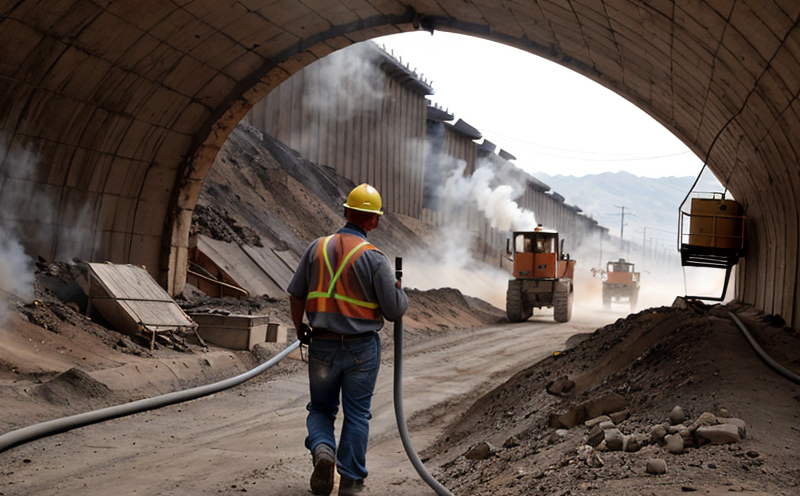NIOSH 7400 Asbestos Fibres PCM Counting Testing
The National Institute for Occupational Safety and Health (NIOSH) Method 7400 is a critical standard used to determine the concentration of asbestos fibers in air samples collected from mining environments. This method employs phase contrast microscopy (PCM), which allows for the accurate identification and counting of asbestos fibers. The primary objective of this testing is to ensure that occupational exposure limits are not exceeded, thereby protecting miners' health.
The NIOSH 7400 test is widely used in industries such as mining where asbestos-containing materials may be present during operations like drilling or blasting. Asbestos can pose serious risks if inhaled; hence, it's essential to monitor air quality regularly and adhere strictly to the permissible exposure limits (PELs) set by regulatory bodies.
The testing process involves collecting an air sample using a suitable sampling device over a specified period before transporting it back to the laboratory for analysis. Once received at our facility, each sample undergoes rigorous preparation steps including digestion to release asbestos fibers from any matrix they might be embedded in. Following this step, PCM is utilized to visually identify and count individual fibers.
It's important to note that while NIOSH Method 7400 provides accurate results, it does have its limitations. For instance, the method cannot differentiate between different types of asbestos (e.g., chrysotile vs amosite), though this limitation is typically not a concern within mining contexts where primarily chrysotile is encountered.
Our lab adheres strictly to international standards such as ISO 14082 when conducting these tests. This ensures that the methodologies used are consistent with global best practices, further enhancing trust in our results and compliance with local regulations.
Scope and Methodology
| Step | Description | Tools/Equipment | Outcome |
|---|---|---|---|
| Sampling | Collect air samples at the workplace using a suitable device over a predetermined duration. | Air sampling pump, filters, and other appropriate equipment. | Collected air samples ready for processing. |
| Sample Processing | Prepare collected samples by digesting them to release asbestos fibers from their matrix. | Digestion reagents, analytical balance. | Fibers released and prepared for microscopy analysis. |
| Microscopy Analysis | Use phase contrast microscopy (PCM) to identify and count individual asbestos fibers. | Phase contrast microscope with high-resolution camera. | Accurate counts of asbestos fiber types present in the air sample. |
| Data Interpretation | Analyze microscopic images to interpret concentrations based on NIOSH guidelines. | Computer software for image analysis and interpretation. | Final report with results aligned against permissible exposure limits (PEL). |
The entire process from sampling through final reporting takes approximately three working days. During this period, our experienced technicians ensure meticulous adherence to NIOSH Method 7400 procedures.
Our commitment to precision and accuracy is further reinforced by using cutting-edge technology and employing skilled personnel who are certified in conducting PCM analyses according to NIOSH guidelines.
Benefits
The implementation of NIOSH 7400 asbestos fibers PCM counting testing offers numerous advantages, particularly for mining operations. By regularly monitoring air quality using this method, employers can ensure that they maintain compliance with occupational safety regulations set forth by various governmental bodies.
This proactive approach not only helps in safeguarding employee health but also reduces potential legal risks associated with non-compliance. Moreover, early detection of asbestos exposure allows for timely interventions such as improved ventilation systems or changes in work practices to minimize further risk.
From a business perspective, maintaining stringent quality assurance measures through consistent testing demonstrates corporate responsibility towards employees' wellbeing. It can enhance reputation among stakeholders while potentially reducing insurance premiums due to demonstrated adherence to safety standards.
The detailed reports generated from these tests provide valuable insights into potential hotspots within mines where increased vigilance is needed. These data points inform decision-makers about necessary preventive measures, ultimately contributing to a safer working environment.
Quality and Reliability Assurance
We take our responsibility to deliver accurate and reliable results very seriously. Our quality management system is ISO 17025 accredited, ensuring that all aspects of the testing process—from sample collection through final analysis—are conducted under controlled conditions.
To maintain high standards, we employ rigorous internal audits and external proficiency tests regularly. These measures help us identify any deviations from expected outcomes early on so corrective actions can be taken promptly.
We also participate in inter-laboratory comparisons organized by recognized bodies to ensure our results align with those produced by other reputable institutions worldwide. This continuous benchmarking ensures that our methodologies remain up-to-date and relevant as regulatory requirements evolve.
In addition, we invest heavily in staff training programs aimed at keeping our personnel abreast of the latest developments in asbestos fiber identification techniques. Regular updates on best practices ensure that our team stays ahead of industry trends, delivering consistently high-quality results.





